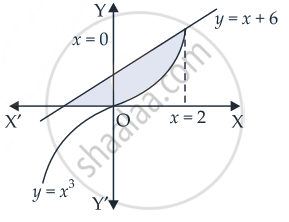Advertisements
Advertisements
Question
Find the area of the region bounded by the curve y = x3 and y = x + 6 and x = 0
Solution

We are given that: y = x3, y = x + 6 and x = 0
Solving y = x3 and y = x + 6
We get x + 6 = x3
⇒ x3 – x – 6 = 0
⇒ x2(x – 2) + 2x(x – 2) + 3(x – 2) = 0
⇒ (x – 2)(x2 + 2x + 3) = 0
x2 + 2x + 3 = 0 has no real roots.
∴ x = 2
∴ Required area of the shaded region
= `int_0^2 (x + 6) "d"x - int_0^2 x^3 "d"x`
= `[x^2/2 + 6x]_0^2 - 1/4 [x^4]_0^2`
= `(4/2 + 12) - (0 + 0) - 1/4 [(2)^4 - 0]`
= `14 - 1/4 xx 16`
= 14 – 4
= 10 sq.units
APPEARS IN
RELATED QUESTIONS
Using integration, find the area of the region bounded by the lines y = 2 + x, y = 2 – x and x = 2.
Find the area under the curve y = \[\sqrt{6x + 4}\] above x-axis from x = 0 to x = 2. Draw a sketch of curve also.
Draw the rough sketch of y2 + 1 = x, x ≤ 2. Find the area enclosed by the curve and the line x = 2.
Using integration, find the area of the region bounded by the line 2y = 5x + 7, x-axis and the lines x = 2 and x = 8.
Find the area of the region bounded by the curve xy − 3x − 2y − 10 = 0, x-axis and the lines x = 3, x = 4.
Find the area bounded by the curve y = cos x, x-axis and the ordinates x = 0 and x = 2π.
Find the area bounded by the ellipse \[\frac{x^2}{a^2} + \frac{y^2}{b^2} = 1\] and the ordinates x = ae and x = 0, where b2 = a2 (1 − e2) and e < 1.
Find the area of the region bounded by x2 = 4ay and its latusrectum.
Using integration, find the area of the region bounded by the triangle ABC whose vertices A, B, C are (−1, 1), (0, 5) and (3, 2) respectively.
Prove that the area in the first quadrant enclosed by the x-axis, the line x = \[\sqrt{3}y\] and the circle x2 + y2 = 4 is π/3.
Find the area enclosed by the curve \[y = - x^2\] and the straight line x + y + 2 = 0.
Find the area bounded by the curves x = y2 and x = 3 − 2y2.
Find the area of the circle x2 + y2 = 16 which is exterior to the parabola y2 = 6x.
Make a sketch of the region {(x, y) : 0 ≤ y ≤ x2 + 3; 0 ≤ y ≤ 2x + 3; 0 ≤ x ≤ 3} and find its area using integration.
The area bounded by y = 2 − x2 and x + y = 0 is _________ .
The area of the region bounded by the parabola (y − 2)2 = x − 1, the tangent to it at the point with the ordinate 3 and the x-axis is _________ .
The area bounded by the curve y = f (x), x-axis, and the ordinates x = 1 and x = b is (b −1) sin (3b + 4). Then, f (x) is __________ .
The area bounded by the curve y2 = 8x and x2 = 8y is ___________ .
Find the area of the region bounded by the curve y2 = 4x, x2 = 4y.
Find the area of the region bounded by the curve y2 = 2x and x2 + y2 = 4x.
Draw a rough sketch of the region {(x, y) : y2 ≤ 6ax and x 2 + y2 ≤ 16a2}. Also find the area of the region sketched using method of integration.
The area of the region bounded by the curve x2 = 4y and the straight line x = 4y – 2 is ______.
The area of the region bounded by parabola y2 = x and the straight line 2y = x is ______.
The area of the region bounded by the curve y = sinx between the ordinates x = 0, x = `pi/2` and the x-axis is ______.
Area of the region bounded by the curve y = |x + 1| + 1, x = –3, x = 3 and y = 0 is
The area bounded by `y`-axis, `y = cosx` and `y = sinx, 0 ≤ x - (<pi)/2` is
For real number a, b (a > b > 0),
let Area `{(x, y): x^2 + y^2 ≤ a^2 and x^2/a^2 + y^2/b^2 ≥ 1}` = 30π
Area `{(x, y): x^2 + y^2 ≥ b^2 and x^2/a^2 + y^2/b^2 ≤ 1}` = 18π.
Then the value of (a – b)2 is equal to ______.
Let P(x) be a real polynomial of degree 3 which vanishes at x = –3. Let P(x) have local minima at x = 1, local maxima at x = –1 and `int_-1^1 P(x)dx` = 18, then the sum of all the coefficients of the polynomial P(x) is equal to ______.
Find the area of the smaller region bounded by the curves `x^2/25 + y^2/16` = 1 and `x/5 + y/4` = 1, using integration.
